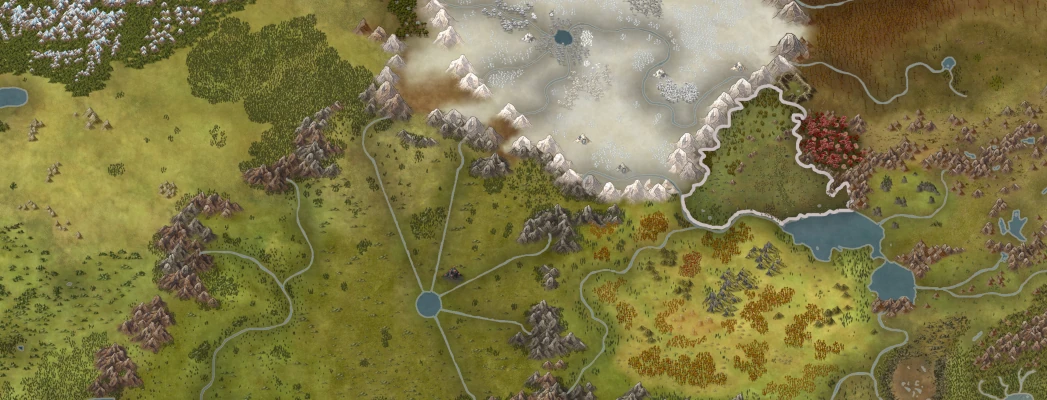Grestvyt
The region of Grestvyt is located in the north-west of Pretheya. It is hemmed in on its western border by the Blasted Mountains, while another mountain range separates it from Ethlarnashem to the north and Pasdjit to the east. From the north, one can reach the Field of Corpses by passing through one of a number of small valleys separating the peaks of the northern mountain range.
Grestvyt was one of the primary theatres of conflict during the Grannr-Leskeln war. Said to have once been a lush and fertile plain ideal for farming in; it was reduced to little more than a mud flat over the course of the war. In the present day, the region is wracked by crippling poverty, and is one of the most economically deprived areas of the continent.
Geography
There is a significant geographical divide between the regions of east and west Grestvyt. The east saw the majority of conflict during the Grannr-Leskeln war and so was left barren and depleted in the following centuries, while the west was left relatively unscathed. In the present day, the western portion of Grestvyt is almost entirely dedicated to farmland. It is responsible for the majority of the country's agricultural production, and is where most of the country's cities and other large population centres are located. The western regions are comparatively hilly and uneven compared to the east. The northernmost region possesses a significant amount of forest coverage, particularly on the border with Refuge; where it has intentionally been left alone in order to serve as a physical border between the two polities. The southern region of the country on the border with Summerlen is known as the Lakeside County; owing to the many small lakes, ponds, and rivers that exist there.Grestvyt
View of the river Enihr in eastern Grestvyt on a foggy day
Controlling Polities: Kingdom of Grestvyt
Racial Majority: Tveirfotr
Minority Races: Thousandforms, Ofirar
Ethnicities: Grestvytian, Moss Ofirar
Inhabitants Demonym: Grestvytian
Average Rainfall: Around 120 days a year
Snow in Winter: Common
Spring Temperatures: 8-16c
Summer Temperatures: 22-30c
Autumn Temperatures: 14-24c
Winter Temperatures: -2 to 10c
now mostly resembles grassy plains. The land is very uneven in some areas, and it is said that one cannot travel more than a mile without finding a crater from the arcanums cast by Grannr and Wyrm esoterikii during the war. The region has also never fully recovered from the total obliteration of much of its native wildlife; with the majority of species that now inhabit it having travelled from elsewhere on the continent rather than being native. Although the Grestvytian people do not understand it and simply attribute it to the results of the war; this ecological damage is why crops can now not grow properly in the region. The lack of pollinating species means that most crops and other plants never become fertilised, and so cannot create food or reproduce. As such, the majority of plant species in eastern Grestvyt are those which can reproduce asexually, or otherwise make do without successful sexual reproduction.
War Landmarks
Eastern Grestvyt is known throughout Pretheya as the "Land of Memorials." Over the more than five hundred year long Grannr-Leskeln war, an uncountable number of humans died in the service of the Wyrms; estimated to have been at least ten million and most likely much more. The majority of these deaths happened just to the north of Grestvyt in the region now known as the Field of Corpses: Of the people who died there, very few were able to have their bodies recovered, and most simply became part of the earth; which is what is thought to have lead to the region's cursed status in the present day.
No small number of men and women also perished in Grestvyt, but there at least they were more often able to be buried. As such, all throughout the eastern portion of the country, and even in some parts of the western region, graves and other burial markers can be found. The oldest and simplest of these date back to the start of the war; simple massed piles of weapons that have long since rusted completely through, and staked
Eventually, however, even this became unsustainable, and the Grestvytian people were forced to begin simply heaping piles of corpses together and burning them on great pyres. Yet even this still left their bones afterwards, and so they took to heaping these together. Once the mound had become large enough, the people would seek out a local esoterikos from the nearest detachment of the Grannr army, and ask them to cover it with earth and mud.
The river Enihr flows through the centre of eastern Grestvyt, and is known for the fact that those who swim or go paddling in it can often find small splinters of human bones at the bottom of the river; where corpses were thrown into it centuries ago in such numbers that their remains can even be found there today. This behaviour is thought to have poisoned the river at some point in the past, and although it should have recovered by the present; most locals still refuse to drink from it, and it has been frequently attested that those who do often become sick afterwards.





